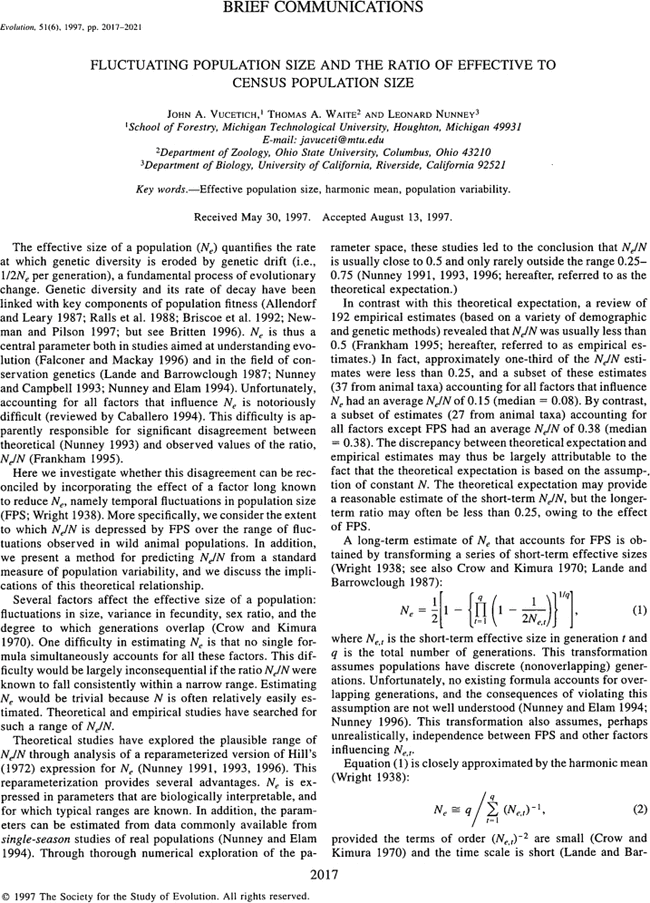Brief Communication
Free Access
FLUCTUATING POPULATION SIZE AND THE RATIO OF EFFECTIVE TO CENSUS POPULATION SIZE
John A. Vucetich,
Thomas A. Waite,
Leonard Nunney,
John A. Vucetich
School of Forestry, Michigan Technological University, Houghton, Michigan, 49931
Search for more papers by this authorThomas A. Waite
Department of Zoology, Ohio State University, Columbus, Ohio, 43210
Search for more papers by this authorLeonard Nunney
Department of Biology, University of California, Riverside, California, 92521
Search for more papers by this authorJohn A. Vucetich,
Thomas A. Waite,
Leonard Nunney,
John A. Vucetich
School of Forestry, Michigan Technological University, Houghton, Michigan, 49931
Search for more papers by this authorThomas A. Waite
Department of Zoology, Ohio State University, Columbus, Ohio, 43210
Search for more papers by this authorLeonard Nunney
Department of Biology, University of California, Riverside, California, 92521
Search for more papers by this authorCorresponding Editor: T. Markow

Literature Cited
- Allendorf, F. W., and R. F. Leary. 1987. Heterozygosity and fitness in natural populations of animals. Pp. 57–76 in M. E. Soulé, ed. Conservation biology. Sinauer, Sunderland, MA.
- Ariño, A., and S. L. Pimm. 1995. The nature of population extremes. Evol. Ecol. 9: 429–443.
- Briscoe, D. A., J. M. Malpica, A. Robertson, G. J. Smith, R. Frankham, R. G. Banks, and J. S. F. Barker. 1992. Rapid loss of genetic variation in large captive populations of Drosophila flies: implications for the genetic management of captive populations. Cons. Biol. 6: 416–425.
- Britten, H. B. 1996. Meta-analyses of the association between multilocus heterozygosity and fitness. Evolution 50: 2158–2164.
- Caballero, A. 1994. Developments in the prediction of effective population size. Heredity 73: 657–679.
- Crow, J. F., and M. Kimura. 1970. An introduction to population genetics theory. Harper and Row, New York.
10.1006/tpbi.1995.1025 Google Scholar
- Dennis, B., P. L. Munholland, and J. M. Scott. 1991. Estimation of growth and extinction parameters for endangered species. Ecol. Monogr. 61: 115–142.
- Falconer, D. S., and T. F. C. Mackay. 1996. Introduction to quantitative genetics. 4th ed. Longman, New York.
- Felsenstein, J. 1971. Inbreeding and variance effective numbers in populations with overlapping generations. Genetics 68: 581–597.
- Frankham, R. 1995. Effective population size/adult population size in wildlife: a review. Genet. Res. 66: 95–107.
- Gaston, K. J., and B. H. McArdle. 1994. The temporal variability of animal abundances: measures, methods, and patterns. Philo. Trans. R. Soc. Lond. B Biol. Sci. 345: 335–358.
- Harris, R. B., and F. W. Allendorf. 1989. Genetically effective population size of large mammals: an assessment of estimators. Cons. Biol. 3: 181–191.
- Hedrick, P. W., and M. E. Gilpin. 1997. Genetic effective size of a metapopulation. Pp. 165–181 in I. A. Hanski and M. E. Gilpin, eds. Metapopulation biology: ecology, genetics, and evolution. Academic Press, New York.
10.1016/B978-012323445-2/50011-0 Google Scholar
- Hill, W. G. 1972. Effective size of populations with overlapping generations. Theor. Popul. Biol. 3: 278–289.
- Lacy, R. C., and T. W. Clark. 1989. Genetic variability in black-footed ferret populations: past, present, and future. Pp. 83–103 in U. S. Seal, E. T. Thome, M. A. Bogan, and S. H. Anderson, eds. Conservation biology and the black-footed ferret. Yale Univ. Press, New Haven, CT.
- Lande, R., and G. F. Barrowclough. 1987. Effective population size, genetic variation and their use in population management. Pages 87–123 in M. E. Soulé, ed. Viable populations for conservation. Cambridge Univ. Press, New York.
10.1017/CBO9780511623400.007 Google Scholar
- Lawton, J. H. 1988. More times means more variation. Nature 334: 563.
- Lewontin, R. C., and D. Cohen. 1969. On population growth in a randomly varying environment. Proc. Nat. Acad. Sci. USA 62: 1056–1060.
- Motro, U., and G. Thomson. 1982. On heterozygosity and effective size of populations subject to size change. Evolution 36: 1059–1066.
- Murdoch, W. M. 1994. Population regulation in theory and practice. Ecology 75: 271–287.
- Newman, D., and D. Pilson. 1997. Increased probability of extinction due to decreased genetic effective population size: experimental populations of Clarkia pulchella. Evolution 51: 354–362.
- Nunney, L. 1991. The influence of age structure and fecundity on effective population size. Proc. R. Soc. Lond. B Biol. Sci. 246: 71–76.
- Nunney, L. 1993. The influence of mating system and overlapping generations on effective population size. Evolution 47: 1329–1341.
- Nunney, L. 1996. The influence of variation in female fecundity on effective population size. Biol. J. Linn. Soc. 59: 411–425.
- Nunney, L., and K. A. Campbell. 1993. Assessing minimum viable population size: demography meets population genetics. Trends Ecol. Evol. 8: 234–239.
- Nunney, L., and D. R. Elam. 1994. Estimating the effective population size of conserved populations. Conserv. Biol. 8: 175–184.
- Pimm, S. L. 1991. The balance of nature? Univ. of Chicago Press, Chicago.
- Pimm, S. L., and A. Redfearn. 1988. The variability of animal populations. Nature 334: 613–614.
- Pray, L. A., C. J. Goodnight, L. Stevens, J. M. Schwartz, and G. Yan. 1996. The effect of population size on effective population size: an empirical study in the red flour beetle Tribolium castaneum. Genet. Res. 68: 151–155.
- Ralls, K., J. D. Ballou, and A. Templeton. 1988. Estimates of lethal equivalents and the cost of inbreeding in mammals. Conserv. Biol. 2: 185–193.
10.1111/j.1523-1739.1988.tb00169.x Google Scholar
- Turchin, P., and A. D. Taylor. 1992. Complex dynamics in ecological time series. Ecology 73: 289–305.
- Vucetich, J. A., R. O. Peterson, and T. A. Waite. 1997. Effects of social structure and prey dynamics on extinction risk in gray wolves. Conserv. Biol. 11: 957–965.
- Waite, T. A., and P. G. Parker. 1996. Dimensionless life histories and effective population size. Conserv. Biol. 10: 1456–1462.
- Williamson, M. H. 1984. The measurement of population variability. Ecol. Entomol. 9: 239–241.
- Wright, S. 1938. Size of a population and breeding structure in relation to evolution. Science 87: 430–431.




